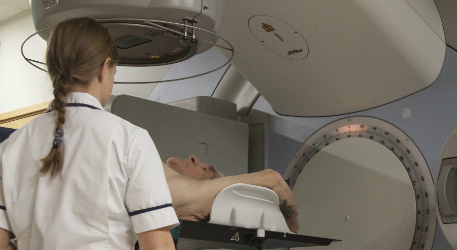What happens when I come in?

Planning
Your doctor or specialist will refer you to us for treatment.
No two people are the same and individual planning for treatment is arranged for every patient. The planning stage is really important and will be thoroughly checked before treatment begins.
Most patients have a planning appointment on the simulator (a special x-ray that lets us look at the treatment area) or CT scanner first.
The area to be treated may be marked with ink or permanent markers. Don't worry if they fade, and don't try to replace the marks yourself.
The marking ink can stain clothes so it is better to wear old clothes on your first visit.
A radiographer will talk to you in our patient information clinic about what to expect from the CT scan, and explain the treatment procedure. They'll be able to answer any questions you may have, and will make sure you've been given written information along with a list of treatment appointments.
There may be a gap between your planning and treatment appointments. This is so that planning calculations and checks can be made to ensure you have a safe and appropriate treatment.
Treatment
We use several types of machine for giving radiotherapy and the radiographer will explain to you exactly what's going to happen during your procedure.
Our radiographers will position you carefully on the treatment couch using the marks and measurements from your planning sessions. You will be asked to keep still and breathe normally.
The radiographer will leave the room to switch on the machine. He or she will watch you closely on CCTV. There is also an intercom so the radiographers can hear you while you are in the treatment room.
The treatment is painless and only takes a few minutes.
The number of treatments given is not related to how seriously ill you are, but depends on the site and type of cancer.
The number of visits people have to make varies from just one appointment, to more than 40 daily appointments.
Afterwards
Although the treatment itself is painless, there are some side effects to having radiotherapy.
These will depend on the area of your body being treated and the dose being given. They will not start immediately but build up over the length of treatment and will vary from person to person.
The side effects will continue for some time after the end of your treatment but subside over time. Your doctor and radiographers will tell you about your treatment and the side effects you may experience. They will also offer advice on how to minimise these side effects.
Common side effects are:
- Skin reactions – After several treatments your skin may become dry, red, itchy and sore. You will be given advice about washing and you should avoid using any skin products that you haven't previously used.
- Tiredness – Some people are able to still enjoy normal activities during treatment while others feel unusually tired. You may find you cannot do as much as you used to before feeling worn out. Rest when you can but try to do some light exercise such as walking.
- Feeling low – You might have feelings of anxiety or fear during or after your treatment. Speak to your doctor or a radiographer. We are here to support you and you can talk to someone if you feel worried.
On the last day of your radiotherapy you will be given some information regarding what to expect once your treatment is complete. You may also have an appointment with your consultant. This may not be until several weeks after you finish, enabling your body time to recover.